CARMELITE NUNS
Traditional Religious Orders
The very name of "Carmel" is in itself an indication of the origin of the Order. Carmel is a mountain in Palestine, which forms part of the Lebanon range. "Carmel" in the Hebrew tongue means "vineyard" or "orchard." Holy Scripture presents Mount Carmel as a fertile and delightful place, and its descriptions are often used in the Liturgy to symbolize the Blessed Virgin Mary. Even to this day, Mount Carmel, surrounded by the sea, remains a site of breathtaking beauty.
 |
|
Tradition traces the origin of the Order back to the Prophet Elias, who first frequented the holy mountain. During a terrible drought, Elias went up on Mount Carmel to implore God's mercy over His people. At his prayer, a small cloud rose from the sea and grew until it covered the entire sky, pouring forth a salutary rain upon the thirsty ground. The Church has always seen in this little cloud a prophetic image of the Blessed Virgin Mary. Pope St. Pius X, in his Encyclical Ad Diem Illum, wrote "Mary was the object of the thoughts of Elias when he was contemplating the cloud rising from the sea."
Carmel, being a place of solitude and very suitable for a life of prayer, became the refuge of the disciples of Elias and Eliseus, who were known as "the Sons of the Prophets." At the time of the Crusades, hermits from the Occident also came to dwell in the natural grottoes so numerous on Mount Carmel. In 1209, St. Albert, Patriarch of Jerusalem, wrote a Rule for the "Brother Hermits of the Blessed Virgin Mary of Mount Carmel." This Rule only codified the form of life that the Hermits had spontaneously adopted. The Saracen invasion forced the Brother Hermits to leave Palestine and seek refuge in Europe. It was at that time that they were given the name of Carmelites.
In 1251, St. Simon Stock, General of the Order, received the Holy Scapular from the hands of our Blessed Mother as a pledge of her protection over the Order.
It was only in the 15th century that Bl. John Soreth established the Carmelite observance for women, and for this reason he is considered as their founder. Little by little, relaxation crept into the Order and the Rule was mitigated, i.e., its primitive austerity was softened. But God raised up St. Teresa of Avila, who reformed the Order and caused the spirit of contemplation to blossom again.
Teresa de Ahumada entered the Carmel of the Incarnation in Avila, where she lived for more than 20 years as a good religious. However, she realized that the lack of a strict enclosure, together with frequent worldly conversations in the parlor, seriously hindered a true life of prayer. With a few companions, she decided to return to the Primitive Rule. In spite of much opposition and many difficulties, she founded the Carmel of St. Joseph in Avila. She extended the reform to the Carmelite Fathers with the help of St. John of the Cross. She spent the last years of her life traveling throughout Spain, founding one Carmel after another. When she died at Alba de Tormes on October 4, 1582, at the age of 67, she had founded 16 Carmels for nuns.
After the death of the holy reformatrix, two of her daughters, Bl. Ann of St. Bartholomew and Ven. Ann of Jesus, founded Teresian Carmels in France and Belgium. The first Carmel in the United States was founded in 1790 by Carmelites from Belgium.
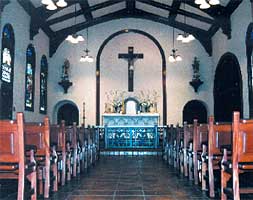 |
|
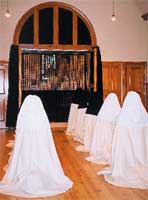 |
|
The public chapel of the Carmel |
|
Assisting at Mass |
The Ideal of Carmel
The ideal of Carmel is a life of prayer and union with God. (Rev. Fr. Francis of St. Mary, O.C.D.)
A very old Carmelite text, The Institutions of the First Monks, tells us the aim of the Order:
This life of Carmel has a double aim: the first is the perfection of charity, which one can reach "with the help of divine grace, through our efforts and virtuous works." The second is "to taste somewhat in the heart and to experience in the soul, not only after death but even in this mortal life, the intensity of the Divine Presence and the sweetness of the glory of heaven."
This contemplation is a gratuitous gift from God who gives it "when, how, and to whom He pleases." But if contemplation is a gratuitous gift from God, the soul nevertheless must dispose herself to it by a generous abnegation and a great fidelity to mental prayer.
Each vocation reproduces the invitation of Jesus to the rich young man. God looks upon us, He is the first to love us and He says: "Come!" But He adds: "if you wish." The soul remains free to respond generously to this invitation. The soul which God calls to Carmel discovers in herself this need to find God, to contemplate Him, and to love Him in the silence of heart-to-heart contact. Attracted by prayer and silent adoration, the soul desires to give herself entirely to God. As the sanctuary lamp before the tabernacle, she wants to consume herself for God alone. Hidden behind the grates, she adores for all those who do not adore, loves for those who do not love, and hopes for those who do not hope. The soul that aspires to Carmel understands that the contemplative life will allow her to concentrate all of her energies on God alone.
The Apostolate of Prayer
One does not leave the world in order to escape from it, but to take it more perfectly in charge before God. (Rev. Fr. Francis of St. Mary, O.C.D.)
St. Teresa of Avila founded the reformed Carmel to counteract the ravages brought about by the Protestant heresies. She stressed this apostolic aim of the Carmel in the first chapters of her Way of Perfection. St. Therese of the Child Jesus understood this very well:
What a noble mission is ours! We offer our prayers and sacrifices for the Apostles of the Lord....It is our responsibility to preserve the salt of the earth.
The Carmelite prays for all of her brothers; nevertheless, priests have a privileged place. "I came to Carmel...above all to pray for priests," said St. Therese of the Child Jesus. Through her prayers and sacrifices, the Carmelite obtains graces for priests to reach souls and lead them to God. She merits graces for souls to be docile to the teaching of the preachers. Bl. Elizabeth of the Trinity, O.C.D., sums up the apostolate of a Carmelite in a letter to a priest:
While you will bring Him to souls, I will stay...silent in adoration before the Master, asking Him to make your words fruitful in souls.
Pope Pius XI declared St. Therese of the Child Jesus Patron of the Missions, on a par with St. Francis Xavier, thus showing the importance of the apostolate of the contemplatives.
 |
|
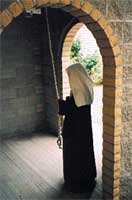 |
|
Making habits |
|
The call to prayer |
Characteristics of Carmelite Spirituality
Solitude
God is not found in the turmoil of the world. The strict enclosure, the grates and veils separate the Carmelite from the world. St. Teresa of Avila clearly said that the only desire of a contemplative is "to be alone with God Alone." In consequence, there is no common workroom in Carmel. Each Sister works alone in her cell or in the workroom that has been allotted to her. God reveals Himself to the solitary heart: "I will lead her into solitude and speak to her heart."
Silence
Together with solitude, silence is one of the dominant notes of Carmel. There are different kinds of silence: silence of action: walking softly, closing doors quietly, and making as little noise as possible...silence of the tongue: avoiding unnecessary conversations or words outside of the two daily recreations...interior silence: silence of the imagination and the memory, which keeps the soul in an atmosphere of recollection and enables her to remain in the presence of God.
The Carmelite makes the motto of the Prophet Elias her own: "He is living, the God in Whose presence I stand." Silence is at one and the same time both asceticism and a necessary condition for the life of continual prayer which is that of the Carmelite. It keeps the soul in a certain expectation, waiting for the Spouse.
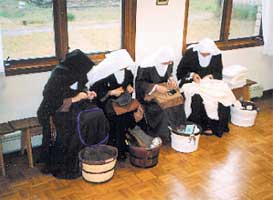 |
|
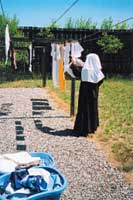 |
|
Recreation |
|
Laundry day |
Detachment
In order to arrive at possessing everything, desire to possess nothing....For, in order to pass from the all to the All, thou hast to deny thyself wholly in all. (St. John of the Cross)
In order to reach the summit of Mount Carmel, it is necessary to take the path of "the Nothing," which alone leads to "the All." The Carmelite adds to silence and solitude a generous and continual effort to be detached from all. If God is to fill the soul, He must find it empty. This implies a work of purification and mortification of all the powers of the soul and of all the senses. There is detachment of the heart, by which we renounce all attachments to material goods (vow of poverty) and also all attachments to creatures (vow of chastity). The vow of obedience helps the religious to detach herself from her own will. "Obedience is the way that leads most quickly to the summit of perfection," said St. Teresa of Avila. To renounce one's will in order to submit to the judgment and will of others is no easy task. To triumph over the many struggles, one needs God's grace and great generosity.
Finally, the soul must be detached even from the complacency she finds in her spiritual exercises and consolations. St. John of the Cross teaches that "love does not consist in feeling great things, but in experiencing great privations and great sufferings for the Beloved."
Mortification
The life of Carmel is austere in itself; simple buildings without decoration, bare white walls, coarse habits (homespun frieze is now replaced by wool cloth). The Carmelite must endure the cold in the winter and the heat in summer. Abstinence from meat is perpetual. The Rule provides, nevertheless, for exemptions to remedy "bodily sickness or feebleness...for necessity has no law" (Rule). The fast of the Order, which is less severe than the fast of the Church during Lent, lasts from September 14 until Easter.
To these mortifications imposed by the Rule, the Carmelite will add all the little acts of mortification which love inspires. St. Therese of the Child Jesus gives us a good example of the little way of renouncing ourselves in little things.
All this should not frighten any applicant. Carmelite life has been adapted so as not to exceed the normal strength of a 21st-century girl.
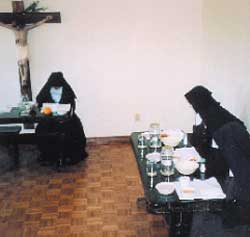 |
|
" You are to eat whatever may have been given you in a common refectory." –Rule
|
Penance
Wishing to fill up those things that are wanting of the sufferings of Christ, in her flesh, for His body, which is the Church, the Carmelite gives herself up to the practice of penance. If the Carmel is austere, it is not, strictly speaking, a penitential order. The penances imposed by the Rule are practiced, not as an end, but as a means of attaining perfection in conformity with Christ. "Do not forget that you are the spouses of a Crucified God," St. Teresa said to her daughters.
Solitude, silence, detachment, and mortification: such are the elements of the active purification undertaken by a soul "kindled in love with yearnings." God Himself will complete the work with passive purifications: sickness, moral and spiritual sufferings. In the crucible of trials, the soul is purified like gold in the furnace in order to be presented to God "holy, pure, and irreprehensible."
Mental Prayer
Mental prayer is the cornerstone of the spirituality of Carmel. All the exercises of the day converge upon the two hours of mental prayer prescribed daily by the Constitution. In turn, it is from mental prayer that all the actions of the day proceed.
Solitude, silence, detachment, and mortification are necessary conditions for mental prayer. If they are the negative aspect of Carmelite spirituality, mental prayer and union with God are its positive aspect and its goal. The emptiness hollowed in the soul by a generous effort of asceticism will be filled by God during prayer. The "Nada" of St. John of the Cross exists only for the "Todo."
In order to be strong, the structure of mental prayer must have a deep humility as its foundation, otherwise the soul could go astray and become the toy of her own illusions or fall prey to the devil.
Provided that the soul is humble and adheres to the doctrine of the Church, she will enjoy a great freedom in mental prayer. In Carmel, neither methods of mental prayer nor subjects for meditation are imposed. However, a certain discipline is required to avoid spiritual laziness. A sound theological knowledge is also necessary in order not to stray from the path of orthodoxy. A weekly spiritual conference given by a priest nourishes the soul of the Carmelite and provides the necessary elements of Catholic dogma.
"The essence of mental prayer is not to think much, but to love much," teaches St. Teresa of Avila. Meditation and reasoning prepare the soul to remain in the presence of God and to speak to Him. This is also the teaching of our holy Mother: "Mental prayer is a friendly intercourse of the soul with Him Who loves her." The more the soul progresses, the more this colloquy becomes simple and occupies the greatest part of her time of prayer. It may even be but a simple loving gaze upon God, until the Lord Himself raises the soul up to Him in contemplation. The value of prayer, however is not measured by the sweetness one may enjoy, but by the generous accomplishment of one's duties, in spite of the repugnance of human nature. Mental prayer leads to a life of union with God, which is defined as the union of our will with the Will of God.
The Order of the Blessed Virgin Mary
Tradition says that the Blessed Virgin Mary gives birth to Carmel. She is the life of the Order, firstly, because she gives us her own life as a model to imitate, as an ideal to obtain; and secondly, because the veneration of Mary is the whole reason for the Order's existence. The Order was founded to honor the Mother of God. (Fr. Gabriel of St. Mary Magdalene, O.C.D.)
We have already seen the important place that Our Lady holds in the development of the Order. She was prophetically announced on Mount Carmel in the little cloud seen by the Prophet Elias around 900 years before her Immaculate Conception. She was called "Sister" by the first Christian hermits, who were honored with the title of "Brothers of the Blessed Virgin Mary of Mount Carmel," and was invoked in the following manner by St. Simon Stock:
Most beautiful flower of Carmel, fruitful vine; Splendor of Heaven, Blessed Mother of the Son of God, Incomparable Mother, Sweet Mother, who knew not man: Grant a pledge of your protection to the children of Carmel.
Mary granted this request in giving the holy Scapular to St. Simon Stock as a sign of her protection over the Order, which hails her as "Regina Decor Carmeli–Queen and Beauty of Carmel."
"Carmel is all Marian" is what the early Carmelites proudly proclaimed, and Our Lady is to be found throughout the history of Carmel. St. Teresa of Avila established her as the Prioress of her monastery; she is the "Virgin of the Smile" of St. Therese of the Child Jesus, and the "Janua Coeli" of Bl. Elizabeth of the Trinity.
Yes, Mary is truly the Queen of Carmel, but as St. Therese put it so well: "She is more Mother than Queen." Each Carmelite has an ardent filial love for the Mother of God, as well as the desire to imitate the silent, hidden, and adoring life of the Blessed Virgin in Nazareth. Our Lady is her model in prayer and in her intimate life with God.
The Divine Office and Holy Mass
As all nuns with solemn vows, the Carmelite is held to the recitation of the breviary. She uses the Roman breviary, completed by the supplement of the Order. The Divine Office is recited in choir on one note (recto tono). This sobriety in the liturgy is characteristic of Carmel and its goal is to concentrate all of the attention on God alone.
The Holy Mass is occasionally chanted in Gregorian. The Carmelites assist at Mass in the choir, but are hidden from sight by the grate and curtains. However, this does not prevent them from seeing the altar. The Holy Mass is the climax of the Carmelite's day. She then offers the day to the unique redeeming Sacrifice of the Cross.
Work
You must give yourselves to work of some kind, so that the devil may always find you busy; no idleness on your part must give him a chance to pierce the defenses of your souls. (Rule)
By her vow of poverty, the Carmelite embraces a life of labor, which is in full accord with the great monastic principle "ora at labora–pray and work."
The employments are varied. There are those that are directed towards the service of the community, such as the laundry, kitchen, sacristy, garden....Then there are those destined to procure some resources for the monastery, such as the making of altar linens and vestments and various other arts and crafts. St. Teresa of Avila wanted her daughters to be occupied by manual work that is not too absorbing, thus leaving the mind free to be occupied with God. The Carmelite works alone, either in her cell or in another assigned place, unless some necessary chore requires the help of the whole community, in which case silence and recollection are, nevertheless, kept.
Recreation
Although a hermit for most of the day, the Carmelite comes together with her sisters twice a day for a period of recreation. These times of relaxation, prescribed by the Constitutions, are spent in a wholly family spirit. On weekdays, the Carmelite brings her work basket to the recreation and continues her usual work while chatting cheerfully with her companions.
St. Teresa has forbidden games at recreation, saying, "Our Lord will give to some the grace of recreating the others." This proves to be very true! Carmelite recreations are always quite lively. The Prioress also profits from the times of recreation to confide particular prayer intentions to the Community and to share with the Sisters any important news of the events in the life of the Church.
The Formation of a Carmelite
The Postulancy
The young lady who aspires to become a Carmelite, teaches St. Teresa, must have sound judgment and good health. A good nervous balance is necessary for someone who wishes to live in a Carmel and will have to bear the solitude and regularity of the monastic life. The entrance to Carmel marks the beginning of the postulancy. During six months (or more, if necessary), the postulant follows the Rule like all the other religious. She submits to the law of enclosure, but remains free to leave the convent if she discovers that she does not have a vocation.
A Sister chosen by the Prioress is given the charming name of "Angel," and will initiate the newcomer to the usages and customs of Carmel. The daily novitiate and the direction of the Mistress of Novices will begin the Carmelite formation of the postulant.
After six months, upon the vote of the Chapter, the postulant is accepted as a novice and will receive the holy habit of Carmel.
The Novitiate
The Novitiate begins with the ceremony of the "Taking of the Habit." In accordance with the regulations made under the pontificate of Pius XII, the postulant receives the habit at the grate of the choir without leaving the enclosure for the ceremony. The novitiate lasts two years. At the end of the two years, upon the vote of the chapter, the novice is allowed to take her temporary vows. The three vows of poverty, chastity, and obedience according to the Primitive Rule of the Order of Mount Carmel are taken for one year. These vows will be renewed every year for six years. The temporary professed sister remains free to leave the Carmel at the end of each year should she realize that she does not have a vocation.
The Solemn Profession
This is the final step and will change the novice into a Carmelite nun. Again, the chapter votes, and if the novice is accepted, she pronounces her solemn and perpetual vows of poverty, chastity, and obedience. The vows are always taken in the chapter room, in the presence of the nuns only. At the end of the Holy Mass following the profession, the newly professed Sister receives the black veil, sign of her consecration to God.
History of the Carmel of the Holy Trinity
The Carmel of the Holy Trinity was founded by the Carmel of the Sacred Heart (in Quievrain, Belgium). We can trace our origins back to the Carmelite Reform undertaken by St. Teresa of Avila. After the death of St. Teresa, a few Spanish Carmelites came to France in 1604, and established the first Reformed Carmel in Paris. Several foundations were then made from the Carmel of Paris. In 1610, one of the Spanish Carmelites went to Bordeaux, where she founded the seventh Carmel of the Reform in France. In 1616, the Carmel of Bordeaux founded a Carmel in Toulouse, which, in turn, founded the Carmel of Limoges in 1618. In 1654, the Carmel of Limoges founded a Carmel in Angouleme. During the religious persecution which raged in France in 1901, the Carmelites were expelled from their Carmel in Angouleme and took refuge in Enghien, Belgium. In 1925, they returned to France and established their Carmel in Tourcoing (Northern France). In 1949, the Carmel was transferred to Parkes, Australia, where it celebrated its third centennial in 1954.
The blood sister of Archbishop Marcel Lefebvre, Mother Marie Christiane, Foundress of the Carmel of Quievrain–hen in the Carmel of Parkes, Australia–knew from her episcopal brother that many vocations were falling away because there was no Carmel in which the Tridentine Mass was offered. Having received the necessary permissions, she returned to Europe, and was later joined by Sr. Marie Pierre. Together, they founded the Carmel of the Sacred Heart, in Quievrain, Belgium, in August, 1978. God blessed the new Carmel. In 12 years, five other Carmels were founded by the Carmel of Quievrain: two Carmels in France, one in Germany, one in Switzerland, and one in the U.S.
In 1984, property was acquired in Phoenixville, Pennsylvania, near Philadelphia. On October 4,1985, our Mother Foundress and six Sisters flew from Brussels to New York. The first Holy Mass was celebrated on October 5 in the tiny chapel of the temporary Carmel. On November 13, 1985, His Grace Archbishop Lefebvre blessed the enclosure and the Sisters resumed their regular cloistered life.
With time, many obstacles proved that it would not be possible to establish a full-sized monastery in Phoenixville. In the summer of 1989, a suitable piece of property was found on the outskirts of Spokane, Washington. Eight months later, the first wing of the Carmel was completed and the Sisters moved into their new home on July 11, 1990.
Our monastery is now entirely completed and awaits all of the generous vocations which Our Lord has chosen for it from all eternity.
For information on this Carmel:
Carmel of the Holy Trinity
S. 4027 Wilbur Road
Spokane, WA 99206
Tel: 509-928-0114
Other traditional Carmels affiliated with the Society of St. Pius X:
Carmel de Sacré Coeur
Rue des Wagnons, 16
B-7380 Quiévrain
BelgiumCarmel du Coeur Immaculé de Marie
15 La Grangeotte
33220 Eynesse
FranceCarmel du T.S. Sacrement
Avenue de Lachomette
43210 Bas en Basset
FranceKarmel St. Josef
Kochbacher Str. 89
59929 Brilon Wald
GermanyCarmel Marie Reine des Anges
Crémières
1071 Chexbres
Switzerland
